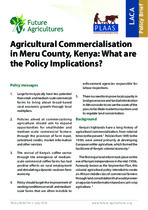| dc.contributor.author | Hakizimana, Cyriaque | |
| dc.date.accessioned | 2019-03-11T07:33:49Z | |
| dc.date.available | 2019-03-11T07:33:49Z | |
| dc.date.issued | 2016 | |
| dc.identifier.citation | Hakizimana, C., 2016. Agricultural commercialisation in Meru County, Kenya: What are the policy implications?, Cape Town: Institute for Poverty Land and Agrarian Studies (PLAAS). | en_US |
| dc.identifier.uri | http://hdl.handle.net/10566/4445 | |
| dc.description.abstract | Our study aimed to engage these debates. The study was carried out in Kenya’s Meru County and examined three agricultural farming models: outgrowers, medium-scale commercial farms and a plantation. This was part of the ‘Land and Agricultural Commercialisation in Africa’ research project conducted in Ghana, Kenya and Zambia. The study provides a comparative perspective across the models on land, labour, employment, livelihoods and economic linkages. It used a mixed methods approach, including qualitative and quantitative methods and detailed life histories. | en_US |
| dc.language.iso | en | en_US |
| dc.publisher | Institute for Poverty Land and Agrarian Studies (PLAAS) | en_US |
| dc.relation.ispartofseries | FAC Policy Brief;84 | |
| dc.subject | Meru County | en_US |
| dc.subject | Kenya | en_US |
| dc.subject | Agricultural commercialization | en_US |
| dc.subject | Policy | en_US |
| dc.title | Agricultural commercialisation in Meru County, Kenya: What are the policy implications? | en_US |
| dc.type | Other | en_US |

